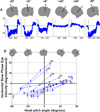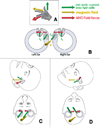MRI magnetic field stimulates rotational sensors of the brain
- PMID: 21945276
- PMCID: PMC3379966
- DOI: 10.1016/j.cub.2011.08.029
MRI magnetic field stimulates rotational sensors of the brain
Abstract
Vertigo in and around magnetic resonance imaging (MRI) machines has been noted for years [1, 2]. Several mechanisms have been suggested to explain these sensations [3, 4], yet without direct, objective measures, the cause is unknown. We found that all of our healthy human subjects developed a robust nystagmus while simply lying in the static magnetic field of an MRI machine. Patients lacking labyrinthine function did not. We use the pattern of eye movements as a measure of vestibular stimulation to show that the stimulation is static (continuous, proportional to static magnetic field strength, requiring neither head movement nor dynamic change in magnetic field strength) and directional (sensitive to magnetic field polarity and head orientation). Our calculations and geometric model suggest that magnetic vestibular stimulation (MVS) derives from a Lorentz force resulting from interaction between the magnetic field and naturally occurring ionic currents in the labyrinthine endolymph fluid. This force pushes on the semicircular canal cupula, leading to nystagmus. We emphasize that the unique, dual role of endolymph in the delivery of both ionic current and fluid pressure, coupled with the cupula's function as a pressure sensor, makes magnetic-field-induced nystagmus and vertigo possible. Such effects could confound functional MRI studies of brain behavior, including resting-state brain activity.
Copyright © 2011 Elsevier Ltd. All rights reserved.
Figures




Comment in
-
Neurophysiology: vertigo in MRI machines.Curr Biol. 2011 Oct 11;21(19):R806-7. doi: 10.1016/j.cub.2011.08.062. Curr Biol. 2011. PMID: 21996500
References
-
- Schenck JF. Human exposure to 4.0-Tesla magnetic fields in a whole-body scanner. Med. Phys. 1992;19:1089. - PubMed
-
- Heilmaier C, Theysohn JM, Maderwald S, Kraff O, Ladd ME, Ladd SC. A large-scale study on subjective perception of discomfort during 7 and 1.5T MRI examinations. Bioelectromagnetics. 2011 - PubMed
-
- Schenck JF. Health and Physiological Effects of Human Exposure to Whole-Body Four-Tesla Magnetic Fields during MRI. AnnNYAcad. Sci. 1992;649:285–301. - PubMed
-
- Glover PM, Cavin I, Qian W, Bowtell R, Gowland PA. Magnetic-field-induced vertigo: A theoretical and experimental investigation. Bioelectromagnetics. 2007;28:349–361. - PubMed
-
- Marcelli V, Esposito F, Aragri A, Furia T, Riccardi P, Tosetti M, Biagi L, Marciano E, Di Salle F. Spatio-temporal pattern of vestibular information processing after brief caloric stimulation. Eur. J. Radiol. 2009;70:312–316. - PubMed
Publication types
MeSH terms
Grants and funding
LinkOut - more resources
Full Text Sources
Medical

